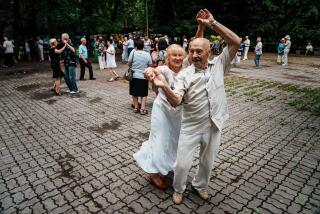Chernobyl Gets Glowing Reviews
- Share via
CHERNOBYL, Ukraine — Yuri Zayets pointed his binoculars toward a distant copse of birches and shouted excitedly from midway up the fire tower: “They’re over there, grazing near the forest.”
It had taken nearly two hours of driving through the unique radioactive wilderness born of the 1986 Chernobyl nuclear disaster to find them, but one of the world’s few wild herds of rare Przewalski horses finally came into view.
“Stay here,” Denis Vishnevsky, a zoologist with the Chernobyl Ecology Center, said after the group of official guides and a journalist piled out of their minibus to see the short but powerfully robust horses, introduced here in 1998 to eat what was supposedly “excess” vegetation in the depopulated area. “They’ll come to us.”
“Chernobyl safaris,” mused Rima Kiselytsia, a guide with Chernobylinterinform, the agency that shepherds all visitors to the “Zone of Alienation” around the now-decommissioned reactor, an area that once was home to 135,000 people. “It’s a strange idea, but I like it.”
Chernobyl tourism has been a hot topic in Ukraine since January, when a U.N. report urged Chernobyl communities to learn to live safely with radiation--such as consuming only produce grown outside the zone. The report suggested specialized tourism as one of several possible ways to bring money into a region that has swallowed more than $100 billion in subsidies from Soviet, Ukrainian and international government funds since the nuclear accident 16 years ago.
Back in the town of Chernobyl, where the zone’s administration manages the Rhode Island-sized no man’s land around the destroyed reactor, one official said economic benefits of tourism will never be more than minor.
But he doesn’t reject the idea outright. “The U.N. is 12 years too late,” said Mykola Dmytruk, deputy director of Chernobylinterinform, referring to technicians who have been coming to the zone for that long. “We’ve been allowing tours since 1994.”
A few Kiev tourist agencies advertise Chernobyl excursions on their Web sites, but so far the zone administration doesn’t actively promote the idea. “A great deal still isn’t known,” said Dmytruk, “and we warn everyone about the risks, even scientists.”
The risks, though small, are real. And so is the desolation. But the aftermath of the accident has created a misleading stereotype of the zone as a toxic wasteland, a nuclear desert devoid of life, and certainly not a place a sane person would want to visit.
In fact, by ending industrialization, deforestation, cultivation and other human intrusions, radiation has transformed the zone into one of Europe’s largest wildlife habitats, a fascinating and at times beautiful wildness teeming with large animals such as moose, wolves, boar and deer. It now is home to 270 bird species, 31 of them endangered--making the zone one of the few places in Europe to spot rarities such as black storks and booted eagles.
And traveling to Chernobyl may qualify as a kind of adventure tourism. The very knowledge of the buzzing background of radiation imbues even the prosaic act of walking down the street with an aura of excitement. It isn’t the same adrenalin punch as bungee jumping in the Andes, but it is a palpable sensation--like being surrounded by ghosts.
By law, no one can enter the zone without permission. But except for children under 17, the administration may give permission to pretty much anyone. The vast majority of the nearly 1,000 annual visitors are scientists, journalists, politicians and international nuclear officials, but the zone has hosted a handful of what Dmytruk calls “pure” tourists--including three Japanese in 2000--and it can put together customized programs, such as safaris in search of Przewalski horses, which some experts believe are the ancestors of all domestic horses but far more aggressive..
“If a group of Californians want to go bird-watching, we can organize that,” Dmytruk said, adding, “so long as they know the difference between plutonium and potatoes.”
Of course, Chernobyl isn’t Club Med. But 16 years after the fourth reactor bloc spewed radiation around the globe, the risks are mostly manageable. About a quarter of the cesium and strontium have already decayed, and 95% of the remaining radioactive molecules are no longer in fallout that can get on or inside a visitor, but have sunk to a depth of about 5 inches in the soil.
From there, they have insinuated themselves into the food chain, making the zone’s diverse and abundant flora and fauna radioactive indeed. An antler shed recently by a Chernobyl elk was stuffed with so much strontium that it cannot be allowed out of the zone. But three Przewalski foals born in the wild, though radioactive, have grown to adolescence with no visible effects.
Such radioactivity now has receded to the background. On an average day, a visitor might receive an extra radiation dose about equivalent to taking a two-hour plane trip, zone officials say.
That is, if the visitor follows the strict but simple safety rules: “Don’t eat local food, stay on the pavement, and go only where your guide takes you,” Dmytruk said.
It is almost impossible to smell fresher air in an urban setting than here in the town of Chernobyl, where the number of cars seen on a warm April day could be counted on one hand and songbirds frequently provide the only sound.
“It is one of the zone’s many paradoxes, but because human activity is banned nearly everywhere, the region is one of Ukraine’s environmentally cleanest,” Dmytruk said. “Except for radiation.”
Today, villages are slowly succumbing to encroaching forests. In the abandoned town of Pripyat, less than two miles from the nuclear reactor, empty black windows stare blindly from high-rise buildings at kindergartens littered with heartbreakingly small gas masks.
It may seem like an odd place for a rewarding tourism experience. But nowhere else can a visitor stand amid a herd of wild Przewalski horses like a character in Jean Auel’s Ice Age novels, or watch a pair of rare white-tailed eagles circling above the ghostly high-rises of Pripyat, a moving monument to the devastating effects of technology gone awry and nature’s near miraculous resilience and recovery.
More to Read
Sign up for The Wild
We’ll help you find the best places to hike, bike and run, as well as the perfect silent spots for meditation and yoga.
You may occasionally receive promotional content from the Los Angeles Times.






